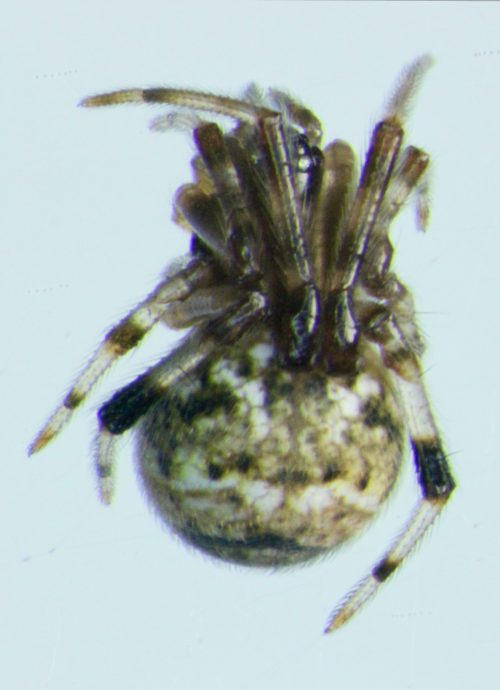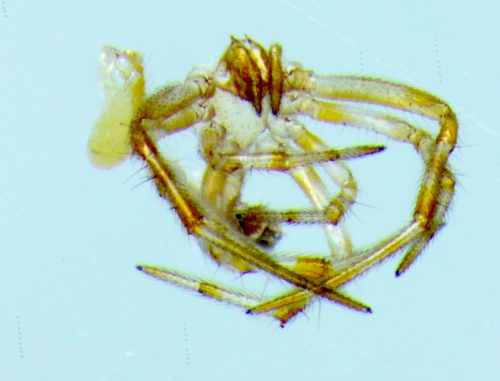Yesterday, Mary startled a jumping spider which had been hiding under a mysterious small object. That object was also attached to the wall of our house by strands of spider silk. Is it an egg sac? I put it under the microscope, and no, it is not.
It is something tiny, about 2mm long, and botanical. I know nothing of botany. It is not a spider thing, which is enough for me.
While I was in the lab anyway, I tended to the spiders, who are all doing fine. Here’s one just relaxing in a spider-like way.
You can just see her dorsal-most eye peeking up between the thicket of legs to make sure I was up to no good. I also noticed that the seam on the dorsal midline of her abdomen was pulsing, something I’ve seen before.
It’s so easy to see and record and measure that I’m thinking this might be the start of an interesting student project — I’ve got a microscope stage warmer, we have ice, I have a laser temperature probe. It might be worth recording heart rate vs. temperature, especially since that’s a significant environmental factor around here. I’ve monitored spiders outdoors, and they start dying off if the ambient temperature gets down around -4°C, which corresponds to the temperature when some species go into dormancy. I may have to try it, if ever we get students working in the research labs again.
By the way, this particular spider may have molted just yesterday.





So now you feed your monsters apple fritters? You are a kind and generous mad scientist.
Can you see that seam pulsing in all spiders, or just freshly molted ones?
I can see it in all the adult Parasteatoda. You just have to catch them with their dorsal side facing the camera, which is tricky since they usually favor hanging upside down.
Eeew, whoo is a good spider (scratches spider on the carapece)
If you put them in a pure oxygen atmosphere, it might allow them to grow to a proper, Mirkwood-esque size.
I’m pretty sure the mystery object is a male cone from a conifer, left over from last spring. It could be Eastern Red Cedar, or maybe Arborvitae.
Yes, psilotum is correct! That is a male conifer cone. (Funny coincidence, I’m a plant biology professor, and I literally discussed psilotum- the whisk fern- in class like 10 minutes ago.)
psilotum & haemolytica: thanks for the info. When I first saw the picture, I thought it looked like a baby pine cone and was kinda cute. I now realize that there’s sexual dimorphism in conifers as well as arachnids.
yes a pollen cone would be light and an easy thing to ‘tie’ in place for a bit of cover from predictors and weather.
just watching the pollen cones swelling up on the local pines around here
uncle frogy
From the title of the video I thought you had just killed one your spiders and I was watching its heart giving its last few beats, slowing down gradually before giving its last. I now see that this is not the case. I don’t whether I should be dissapointed.
Anyway, watching a spider’s heart beating like that was really fascinating.
Thanks for sharing. 😉👌🏼